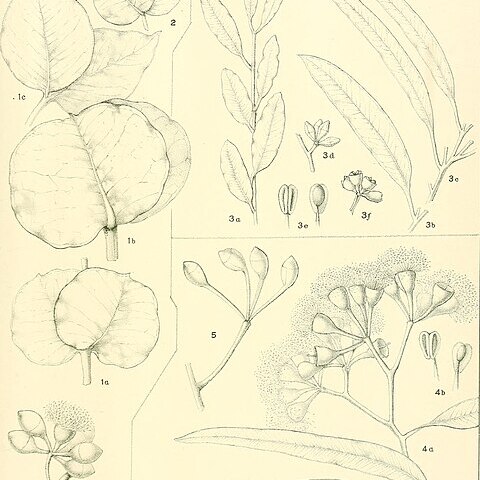Mallee to 8 m tall. Lignotuberous.Bark rough, black or grey-black, coarsely flaky and fissured to hard and compact for about half of trunk, branches smooth, grey cream and orange.Branchlets with oil glands in pith. Juvenile growth (coppice or field seedlings to 50 cm): not grown. Adult leaves alternate, petioles 1–1.8 cm long; blade lanceolate or becoming slightly falcate, 7.4–11 cm long, 0.8–1.5 cm wide, base tapering to petiole, margin entire, apex acute, glossy, green, side-veins at an acute or wider angle to midrib, reticulation usually dense, intramarginal vein remote from margin, oil glands intersectional. Inflorescence axillary unbranched, peduncles 0.5–1.4 cm long, buds 7 per umbel, sessile or pedicels to 0.2 cm long. Mature buds more or less ovoid, 0.7–0.8 cm long, 0.4–0.5 cm wide, but operculum may be wider than or equal to hypanthium at the join, scar present, operculum conical or shortly beaked, stamens inflexed, anthers ± wedge-shaped, versatile, dorsifixed, dehiscing by longitudinal slits, style straight, long, stigma rounded to tapering, locules 4, the placentae each with 4 vertical rows of ovules. Flowers white. Fruit sessile or rarely shortly pedicellate (pedicels 0–0.2 cm long), cupular to obconical, 0.4–0.5 cm long, 0.5–0.6 cm wide, disc descending, valves 4, near rim level. Seeds reddish brown and glossy, 0.8–2 mm long, flattened-ovoid and often angular in outline, dorsal surface sometimes lacunose, shallowly reticulate, hilum ventral.Cultivated seedlings (measured at ca node 10): not grown.
More
Tree to 15 m. Bark rough, fibrous, black to 4 m, then smooth, grey to light brown above. Juvenile leaves ovate to oblong, slightly glaucous. Adults leaves narrowly lanceolate, uncinate, thick; lamina 8–12 cm long, 0.8–1.5 cm wide, shining, green; lateral veins faint, at 30°–35°; intramarginal vein up to 1 mm from margin; petiole terete to quadrangular, 10–20 mm long. Umbels 7-flowered; peduncle flattened or angular, 5–10 mm long; pedicels absent. Buds cylindrical to ovoid; operculum conical, striate or ribbed, sometimes slightly rostrate, 4–5 mm long, 3–4 mm wide; hypanthium hemispherical or obconical, 4–5 mm long, 3–4 mm wide. Fruits ±cylindrical or hemispherical, smooth when fresh, wrinkled or striate when dry, 5–6 mm long and wide; valves 3 or 4, just exserted.


